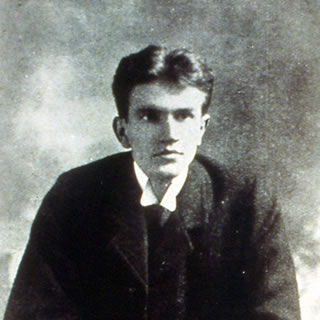
In his pamphlet “Monkeyshines: Fakes, Fables, Facts Concerning Evolution” (1926), the creationist Harry Rimmer claims that he studied “under men who were strong believers in the theory of monkey ancestry of man,” yet “it is quite common today to meet folks who will say that the evolutionists never claimed that man was descended from the monkey family at all.” To refute these folks, as I explained in part 1, he cites “a noted authority, W. P. Barbellion,” who in fact is W. N. P. (for Wilhelm Nero Pilate) Barbellion, born Bruce Frederick Cummings (1889–1919), famous for his authorship of a diary he kept from the age of thirteen, eventually published as The Journal of a Disappointed Man (1919). What he was disappointed by was the fact that his early death loomed.
Barbellion’s great ambition in his early life was to secure a post in the British Museum of Natural History. Visiting the museum in 1910, he wrote with awe, “It is a magnificent building—too magnificent to work there … A pious zoologist might go up to pray in it—but not to earn his daily bread there.” But he wasn’t in a good position to realize his ambition. He wasn’t from a rich family; he didn’t have a college education; he was busy laboring on his father’s newspaper six days a week, leaving barely any time for his scientific studies. Nevertheless, in 1910, he managed to get nominated to take a competitive examination for a post at the museum. There were three posts open; he placed fourth. The next year, there were only two posts open. But he placed first.
In 1912, Barbellion began work at the museum with high aspirations: “I should be disappointed if at the end of my career (if I live to see it through) I do not win the F.R.S.” By the end of the year, though, he was beginning to find the work dull—“I am living on my immense initial momentum—while the machinery gradually slows up.” Symptoms of his multiple sclerosis were already apparent, but he was not aware of the nature of his illness until reading a letter that his doctor gave him to take to the recruiting office when he was summoned to enlist in the British Army in 1915. He resigned from the museum in 1916, writing, “I was the ablest junior on the staff and one of the ablest zoologists in the place—but my ability was always muffled by the inferior work they gave me to do.”
No doubt Barbellion became a competent scientist. During his stint at the British Museum of Natural History, he was in charge of the entomological collections of four insect orders: Neuroptera, Isoptera, Mallophaga, and Auroplura. According to the Oxford Dictionary of National Biography, “These positions carried considerable research and curatorial responsibility; his appointment was a remarkable achievement for one who had no formal training in the subject.” The demands of the First World War made his entomological work relevant—one of the most compelling sections of his journal, entitled “Lice or ‘Creeping Ferlies’” (the allusion is to a poem by Robert Burns), begins, “I probably know more about Lice than was ever before stored together within the compass of a single human mind!” But was he “a noted authority,” as Rimmer claims?
Well, no. In the first place, it’s clear that the passage quoted by Rimmer is the expression of a personal opinion of a diarist rather than a professional judgment of a scientist. (This, by the way, is no less true of the passages in which Barbellion is mooning over girls: “those coal-black eyes. Ah! me, she is pretty” [emphasis in original].) What Barbellion wrote in his journal about “the brute creation” was:
How I hate the man who talks about the “brute creation,” with an ugly emphasis on brute. Only Christians are capable of it. As for me, I am proud of my close kinship with other animals. I take a jealous pride in my Simian ancestry. I like to think that I was once a magnificent hairy fellow living in the trees and that my frame has come down through geological time via sea jelly and worms and Amphioxus, Fish, Dinosaurs, and Apes. Who would exchange these for the pallid couple in the Garden of Eden? (emphasis in original)
(Rimmer made a few mistakes in transcribing the passage, and also, perhaps by design, omitted the second sentence.) In the second place, the passage is dated to July 22, 1910, before Barbellion was a professional scientist, which would seem to be a basic prerequisite for considering him as “a noted authority” on a scientific topic—not that judgments about whether a given ancestry warrants pride are scientific, I should add.
Where did Rimmer run across the passage from Barbellion? There are a number of possible sources. He might have read The Journal of a Disappointed Man: it received a lot of publicity when it was published, thanks in large part to the inclusion of a foreword from H. G. Wells—who, it will be remembered, was a student of T. H. Huxley, and who said of Barbellion “that in him biological science loses one of the most promising of its recent recruits.” Or he might have seen it as the epigraph to Clarence Day Jr.’s This Simian World (1920), the first success of the author of Life with Father (1935), which similarly omits the second sentence. Or it might just be one of those quotations that, denuded of their context, forever ornament the creationist literature.

